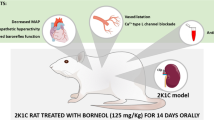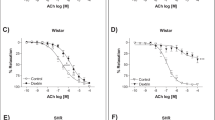Abstract
The aim of this study is to evaluate the effects of hypercholesterolemia in thoracic aorta (TA), mesenteric artery (MA), renal artery (RA), and corpus cavernosum (CC) isolated from cholesterol-fed rabbits. For determination of the maximum detrimental effect, vasorelaxation and vasoconstriction results of arteries and CC have been compared. Animals were fed with a diet that contained 2% w/w cholesterol and 2% w/w high cholesterol plus resveratrol (4 mg kg–1 per day) for 6-week duration. Total cholesterol levels in the plasma were measured. Vascular and endothelial functions in RA, TA, MA, and CC were assessed by isolated tissue bath with cumulative doses of acetylcholine and sodium nitroprusside. The statistical significance of differences of groups was analyzed by means of one-way ANOVA or Student's t-test. P-values <0.05 were considered significant. There have been no significant changes on plasma total cholesterol levels between cholesterol and cholesterol + resveratrol-treated groups. Vasorelaxation responses to acetylcholine in resveratrol-treated group showed significant changes when compared with hypercholesterolemic group. No statistically significant differences were seen between non-receptor-mediated vasorelaxation responses between the three groups. Resveratrol might be an effective treatment in the prevention of atherosclerotic changes in arteries and CC. The initial effects of hypercholesterolemia on erectile dysfunction and endothelial dysfunction may be precluded with resveratrol. This protective effect may also ensure the prevention of coronary arterial diseases and renovascular diseases in hypercholesterolemic patients.
This is a preview of subscription content, access via your institution
Access options
Subscribe to this journal
Receive 8 print issues and online access
$259.00 per year
only $32.38 per issue
Buy this article
- Purchase on Springer Link
- Instant access to full article PDF
Prices may be subject to local taxes which are calculated during checkout




Similar content being viewed by others
References
Montorsi F, Briganti A, Salonia A, Rigatti P, Margonato A, Macchi A et al. Erectile dysfunction prevalence, time of onset and association with risk factors in 300 consecutive patients with acute chest pain and angiographically documented coronary artery disease. Eur Urol 2003; 44: 360–364.
Kloner RA, Mullin SH, Shook T, Matthews R, Mayeda G, Burstein S et al. Erectile dysfunction in the cardiac patient: how common and should we treat? J Urol 2003; 170: 46–50.
Solomon H, Man JW, Wierzbicki AS, Jackson G . Relation of erectile dysfunction to angiographic coronary artery disease. Am J Cardiol 2003; 91: 230–231.
Min JK, Williams KA, Okwuosa TM, Bell GW, Panutich MS, Ward RP . Prediction of coronary heart disease by erectile dysfunction in men referred for nuclear stress testing. Arch Intern Med 2006; 166: 201–206.
Ponholzer A, Temml C, Obermayr R, Wehrberger C, Madersbacher S . Is erectile dysfunction an indicator for increased risk of coronary heart disease and stroke? Eur Urol 2005; 48: 512–518.
Gazzaruso C, Giordanetti S, De Amici E, Bertone G, Falcone C, Geroldi D et al. Relationship between erectile dysfunction and silent myocardial ischemia in apparently uncomplicated type 2 diabetic patients. Circulation 2004; 110: 22–26.
Vlachopoulos C, Rokkas K, Ioakeimidis N, Aggeli C, Michaelides A, Roussakis G et al. Prevalence of asymptomatic coronary artery disease in men with vasculogenic erectile dysfunction: a prospective angiographic study. Eur Urol 2005; 48: 996–1002.
Gotto AM, Grundy SM . Lowering LDL-cholesterol: questions from recent analysis of clinical trials. Data from the Interdisciplinary Council of Reducing the Risk for Coronary Heart Disease. Circulation 1999; 99: 1–7.
Shindel AW, Kishore S, Lue TF . Drugs designed to improve endothelial function: effects on erectile dysfunction. Curr Pharm Des 2008; 14: 3758–3767.
Schmitz G, Langmann T . Pharmacogenomics of cholesterol-lowering therapy. Vascul Pharmacol 2006; 44: 75–89.
Kalsi JS, Ralph DJ, Thomas P, Bellringer J, Minhas S, Kell PD et al. A nitric oxide-releasing PDE5 inhibitor relaxes human corpus cavernosum in the absence of endogenous nitric oxide. J Sex Med 2005; 2: 53–57.
Ghatta S, Ramarao P . Increased contractile responses to 5-hydroxytryptamine and Angiotensin II in high fat diet fed rat thoracic aorta. Lipids Health Dis 2004; 3: 19.
Macovei L . Pleiotropic effects of therapy in endothelial dysfunction syndrome. Rev Med Chir Soc Med Nat Iasi 2004; 108: 17–22.
Kensey KR . The mechanistic relationships between hemorheological characteristics and cardiovascular disease. Curr Med Res Opin 2003; 19: 587–596.
Shi Q, Vandeberg JF, Jett C, Rice K, Leland MM, Talley L et al. Arterial endothelial dysfunction in baboons fed a high-cholesterol, high-fat diet. Am J Clin Nutr 2005; 82: 751–759.
Vane JR, Anggard EE, Botting RM . Regulatory functions of the vascular endothelium. N Engl J Med 1990; 323: 27–36.
Kang SY, Kim SH, Schini VB, Kim ND . Dietary ginsenosides improve endothelium-dependent relaxation in the thoracic aorta of hypercholesterolemic rabbit. Gen Pharmacol 1995; 26: 483–487.
Müller S, König I, Meyer W, Kojda G . Inhibition of vascular oxidative stress in hypercholesterolemia by eccentric isosorbide mononitrate. J Am Coll Cardiol 2004; 44: 624–631.
Sanz M, Ganado P, Tejerina T . Two angiotensin AT1 receptor antagonists, irbesartan and losartan, effects in cholesterol-fed rabbits. Eur J Pharmacol 2002; 442: 99–106.
Lenich CM, Chobanian AV, Brecher P, Zannis VI . Effect of dietary cholesterol and alloxan-diabetes on tissue cholesterol and apolipoprotein E mRNA levels in the rabbit. J Lipid Res 1991; 32: 431–438.
Penumathsa SV, Thirunavukkarasu M, Koneru S, Juhasz B, Zhan L, Pant R et al. Statin and resveratrol in combination induces cardioprotection against myocardial infarction in hypercholesterolemic rat. J Mol Cell Cardiol 2007; 42: 508–516.
Wang Z, Zou J, Cao K, Hsieh TC, Huang Y, Wu JM . Dealcoholized red wine containing known amounts of resveratrol suppresses atherosclerosis in hypercholesterolemic rabbits without affecting plasma lipid levels. Int J Mol Med 2005; 16: 533–540.
Wilson T, Knight TJ, Beitz DC, Lewis DS, Engen RL . Resveratrol promotes atherosclerosis in hypercholesterolemic rabbits. Life Sci 1996; 59: 15–21.
Safian RD, Textor SC . Renal-artery stenosis. N Engl J Med 2001; 344: 431–442.
Piepot HA, Groeneveld AB, van Lambalgen AA, Sipkema P . Endotoxin impairs endothelium-dependent vasodilation more in the coronary and renal arteries than in other arteries of the rat. J Surg Res 2003; 110: 413–418.
Moncada S, Higgs EA . Molecular mechanisms and therapeutic strategies related to nitric oxide. FASEB J 1995; 9: 1319–1330.
Furchgott RF . Endothelium-derived relaxing factor: discovery, early studies, and identification as nitric oxide. Biosci Rep 1999; 19: 235–251.
Jaiswal N, Lambrecht G, Mutschler E, Tacke R, Malik KU . Pharmacological characterization of the vascular muscarinic receptors mediating relaxation and contraction in rabbit aorta. J Pharmacol Exp Ther 1991; 258: 842–850.
Fisher Jr DF, Fry WJ . Collateral mesenteric circulation. Surg Gynecol Obstet 1987; 164: 487–492.
AbuRahma AF, Stone PA, Bates MC, Welch CA . Angioplasty/stenting of the superior mesenteric artery and celiac trunk: early and late outcomes. J Endovasc Ther 2003; 10: 1046–1053.
White CR, Parks DA, Patel RP, Shelton J, Tarpey MM, Freeman BA et al. L-Arginine inhibits xanthine oxidase-dependent endothelial dysfunction in hypercholesterolemia. FEBS Lett 2004; 561: 94–98.
McCullough AR . The penis as a barometer of endothelial health. Rev Urol 2003; 5: 3–8.
Author information
Authors and Affiliations
Corresponding author
Ethics declarations
Competing interests
The authors declare no conflict of interest.
Rights and permissions
About this article
Cite this article
Soner, B., Murat, N., Demir, O. et al. Evaluation of vascular smooth muscle and corpus cavernosum on hypercholesterolemia. Is resveratrol promising on erectile dysfunction?. Int J Impot Res 22, 227–233 (2010). https://doi.org/10.1038/ijir.2010.8
Received:
Revised:
Accepted:
Published:
Issue Date:
DOI: https://doi.org/10.1038/ijir.2010.8
Keywords
This article is cited by
-
Resveratrol treatment may preserve the erectile function after radiotherapy by restoring antioxidant defence mechanisms, SIRT1 and NOS protein expressions
International Journal of Impotence Research (2018)
-
Resveratrol reverses diabetes-related decrement in sildenafil-induced relaxation of corpus cavernosum in aged rats
Aging Clinical and Experimental Research (2017)
-
Acute effect of rosiglitazone on relaxation responses in hypercholesterolemic corpus cavernosum
International Journal of Impotence Research (2016)



